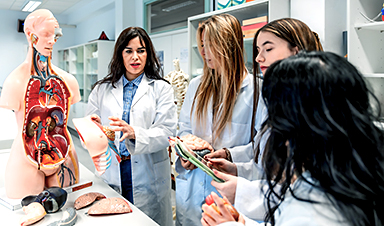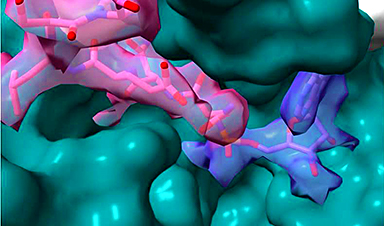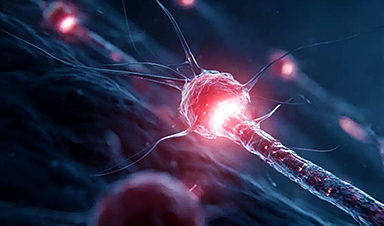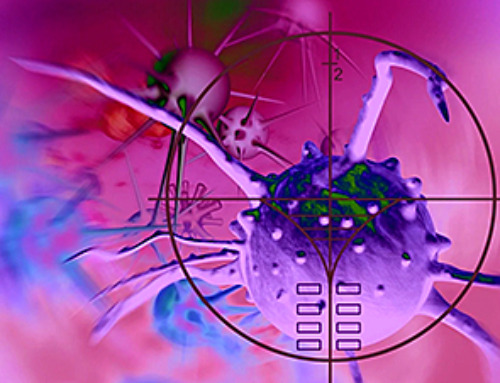Key Points
-
Monash researchers have developed a method to prepare elongated nanocrystals to deliver therapeutic drugs
-
Elongated nanocrystals can carry a high payload of drugs to potentially increase drug targetability and also decrease dosage frequency and side effects
- The researchers used a combination of deuteration, X-ray and neutron techniques at ANSTO to distinguish the three layers of the nanocrystal
Monash University researchers have used advanced techniques at ANSTO to investigate the production of new, elongated polymer nanocapsules with a high payload of drug nanocrystals to potentially increase drug targetability, and also decrease dosage frequency and side effects.
This method had not been investigated previously and represents a pioneering method of investigation in the field of colloidal science applications for drug delivery.
Nanoparticles have been used to increase the delivery efficiency of cancer therapy because of their biocompatibility, versatility and the easiness of functionalisation.
The team engineered novel elongated polymer nanocapsules, which are unlike the more well-known spherical nanocapsules.
The elongated polymer nanocapsules were made with elongated liposomes or surfactant vesicles and used drug nanocrystals as a template.
The results provided strong evidence that the elongated structure could be retained, and also confirmed that the loading method to form rod-like drug nanocrystals inside liposomes was a practical solution.
The combination of the high drug payload, in the form of encapsulated nanocrystals, and the non-spherical feature of liposomes represented a more efficient delivery system.
Spherical hollow nanocapsules have been studied extensively, but the formation of elongated nanocapsules containing active pharmaceuticals as therapeutic agents has been previously largely unsuccessful.
“There are difficulties in retaining the elongated shape and their encapsulation efficiency is low,” explained researcher Yunxin (Cindy) Xiao, a PhD candidate working in the Nonlaminar group with Prof Ben Boyd at the Monash Biomedicine Discovery Institute. and the recipient of the Australian Institute of Nuclear Science and Engineering Post Graduate Research Award.
“The elongated shape is better because it is more difficult for immune cells to internalise them and because their therapeutic efficiency at the target site can be maximised.”
After obtaining promising structural results using a liposomal template investigated using the small angle X-ray scattering beamline at ANSTO’s Australian Synchrotron and the small and ultra-small small-angle neutron scattering instruments Bilby and Kookaburra in previous research, the template was used to form elongated polymer nanocapsules.
The researchers used vesicles made of surfactants as templates, which allowed for the polymerisation of a less permeable shell inside these….
News
Most Plastic in the Ocean Is Invisible—And Deadly
Nanoplastics—particles smaller than a human hair—can pass through cell walls and enter the food web. New research suggest 27 million metric tons of nanoplastics are spread across just the top layer of the North [...]
Repurposed drugs could calm the immune system’s response to nanomedicine
An international study led by researchers at the University of Colorado Anschutz Medical Campus has identified a promising strategy to enhance the safety of nanomedicines, advanced therapies often used in cancer and vaccine treatments, [...]
Nano-Enhanced Hydrogel Strategies for Cartilage Repair
A recent article in Engineering describes the development of a protein-based nanocomposite hydrogel designed to deliver two therapeutic agents—dexamethasone (Dex) and kartogenin (KGN)—to support cartilage repair. The hydrogel is engineered to modulate immune responses and promote [...]
New Cancer Drug Blocks Tumors Without Debilitating Side Effects
A new drug targets RAS-PI3Kα pathways without harmful side effects. It was developed using high-performance computing and AI. A new cancer drug candidate, developed through a collaboration between Lawrence Livermore National Laboratory (LLNL), BridgeBio Oncology [...]
Scientists Are Pretty Close to Replicating the First Thing That Ever Lived
For 400 million years, a leading hypothesis claims, Earth was an “RNA World,” meaning that life must’ve first replicated from RNA before the arrival of proteins and DNA. Unfortunately, scientists have failed to find [...]
Why ‘Peniaphobia’ Is Exploding Among Young People (And Why We Should Be Concerned)
An insidious illness is taking hold among a growing proportion of young people. Little known to the general public, peniaphobia—the fear of becoming poor—is gaining ground among teens and young adults. Discover the causes [...]
Team finds flawed data in recent study relevant to coronavirus antiviral development
The COVID pandemic illustrated how urgently we need antiviral medications capable of treating coronavirus infections. To aid this effort, researchers quickly homed in on part of SARS-CoV-2's molecular structure known as the NiRAN domain—an [...]
Drug-Coated Neural Implants Reduce Immune Rejection
Summary: A new study shows that coating neural prosthetic implants with the anti-inflammatory drug dexamethasone helps reduce the body’s immune response and scar tissue formation. This strategy enhances the long-term performance and stability of electrodes [...]
Scientists discover cancer-fighting bacteria that ‘soak up’ forever chemicals in the body
A family of healthy bacteria may help 'soak up' toxic forever chemicals in the body, warding off their cancerous effects. Forever chemicals, also known as PFAS (per- and polyfluoroalkyl substances), are toxic chemicals that [...]
Johns Hopkins Researchers Uncover a New Way To Kill Cancer Cells
A new study reveals that blocking ribosomal RNA production rewires cancer cell behavior and could help treat genetically unstable tumors. Researchers at the Johns Hopkins Kimmel Cancer Center and the Department of Radiation Oncology and Molecular [...]
AI matches doctors in mapping lung tumors for radiation therapy
In radiation therapy, precision can save lives. Oncologists must carefully map the size and location of a tumor before delivering high-dose radiation to destroy cancer cells while sparing healthy tissue. But this process, called [...]
Scientists Finally “See” Key Protein That Controls Inflammation
Researchers used advanced microscopy to uncover important protein structures. For the first time, two important protein structures in the human body are being visualized, thanks in part to cutting-edge technology at the University of [...]
AI tool detects 9 types of dementia from a single brain scan
Mayo Clinic researchers have developed a new artificial intelligence (AI) tool that helps clinicians identify brain activity patterns linked to nine types of dementia, including Alzheimer's disease, using a single, widely available scan—a transformative [...]
Is plastic packaging putting more than just food on your plate?
New research reveals that common food packaging and utensils can shed microscopic plastics into our food, prompting urgent calls for stricter testing and updated regulations to protect public health. Beyond microplastics: The analysis intentionally [...]
Aging Spreads Through the Bloodstream
Summary: New research reveals that aging isn’t just a local cellular process—it can spread throughout the body via the bloodstream. A redox-sensitive protein called ReHMGB1, secreted by senescent cells, was found to trigger aging features [...]
AI and nanomedicine find rare biomarkers for prostrate cancer and atherosclerosis
Imagine a stadium packed with 75,000 fans, all wearing green and white jerseys—except one person in a solid green shirt. Finding that person would be tough. That's how hard it is for scientists to [...]





















